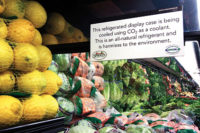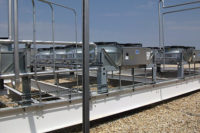Supermarkets
In a paper called “Application of Ammonia in U.S. Supermarkets,” Caleb Nelson with CTA Architects said barricades to broader use of ammonia in food stores have been due to “misconceptions of ammonia (R-717) and the codes that govern it, coupled with a lack of knowledge pertaining to the systems.”
He acknowledged a food store system cannot be configured the same as larger industrial refrigeration applications. “Therefore, an outdoor rooftop ammonia chiller is the most feasible option. A packaged type of system with the refrigerant charge residing outdoors alleviates the potential for accidents involving employees and customers within the building.”
According to Nelson, his search of international codes “show no major deterring restrictions have been found in the use of an ammonia system in a supermarket, although some local requirements may preclude such installations in some parts of the U.S.”
He further suggested, “Possibly the best approach would be to avoid these areas [to begin with] when considering locations to implement ammonia commercially.”
Among system approaches, Nelson noted those with liquid overfeed and use of low pressure receivers.
He added, “There are additional system qualities that are crucial in order for ammonia to be successfully implemented in U.S. supermarkets. First of all, tight, factory-built systems will need to be applied in order to reduce the probability of leaks. Secondly, manufacturers will need to look for every opportunity to keep the system costs as low as possible. Thirdly, it will be desirable for the systems to be maintainable by commercial technicians.
“Although additional technician training will be necessary for this to be possible, any opportunity to integrate ‘familiarity’ into the systems should be taken. For example, utilizing reciprocating compressors instead of screw compressors would be the more familiar option since the overwhelming majority of U.S. supermarkets use reciprocating compressors today.”
Heat Pumps
The presentation from Sam Gladis and Mark Stencel of Vilter as well as Don Stroud of Kraft Foods talked about a high-temperature ammonia heat pump approach, noting: “Due to recent high pressure screw compressor developments, the industrial refrigeration industry is positioned to employ ammonia heat pump systems to harvest waste heat and to enhance the profitability and environmentally sound operation of food and beverage processing facilities.”
The presentation reported on a real-life case history about the development, design, installation, and operation of an ammonia heat pump system at a food processing facility in Iowa. According to the presenters, “The installation was completed as an addition to an existing industrial refrigeration system, and the savings generated by its operation are now occurring. These savings have been measured and will total hundreds of thousands of dollars annually.”
The approach involved the following: “The flow of refrigerant through the ammonia heat pump system would be routed from the compressor discharge of the plant’s refrigeration system into the heat pump package, flowing through a desuperheater, then the single screw heat pump compressor unit, a shell and tube condenser, a shell and tube subcooler, a pneumatic expansion valve, and back to the condensed liquid side of the existing refrigeration system. Propylene glycol at 75˚F would flow through a secondary loop from a plate heat exchanger through the heat pump, circuited initially through the subcooler, then desuperheater, oil cooler, condenser, and returning to the plate heat exchanger at 155˚.”
Ammonia Absorption
A report from Donald Erikson of Energy Concepts noted that “Ammonia Absorption Refrigeration (AAR) is poised to move beyond niche applications and into the mainstream of industrial refrigeration.”
According to Erikson, “Driven by the need to conserve energy and reduce operating cost, numerous improvements and advancements have been made to AAR technology.” He cited such improvements as “new heat and mass exchange components and new cycle enhancements.”
Erikson also noted that ammonia absorption technology dates back to 1858 when an AAR machine was used to create refrigeration. The approach remained in effect until the 20th century, when it was replaced by mechanical compression.
He cited a number of projects that have found ways to overcome historical limitations, including:
• A mill that has a 150-ton thermal heat pump with AAR.
• A melon storage warehouse with a 160-ton AAR in a combined chilling power application with both exhaust heat and jacket heat supplied to produce the chilling.
• A 2,000-ton AAR for turbine inlet air chilling where direct contact heat exchange is used extensively.
The CO2 Aspect
The use of CO2 was described in both secondary coolant and cascade approaches. The CO2 secondary coolant-based system was detailed by Hernan Hildalgo and Anatolii Mikhailov of Danfoss A/S.
Traditionally, they said, “CO2 systems were built for low-temperature applications due to the high efficiency associated with it. However, plants that have a demand for both low- and medium-temperature requirements could also benefit from applying CO2 to the medium-temperature loop such as process areas, warehouses, banana rooms, etc.
“The medium-temperature side is typically a pumped circulation loop connecting the cascade heat exchanger to the rest of the system. Nevertheless, stand-alone installations with a CO2 medium-temperature loop are also viable.”
Other elements that figure into increased efficiency and plant safety, according to the report, include the following: a pump package including the use of variable-frequency drives; pressure control including anticipating standstill pressure conditions; defrost strategies such as electric defrost, hot gas defrost, water defrost, and hot brine defrost; and valve sizing criteria.
The CO2 in the cascade approach was described by Klaas Visser of KAV Consulting. He noted, “It is unlikely that ammonia will ever be pumped around a building due to its toxicity.”
But Visser did say that both indirect ammonia and CO2 systems are ideally suited to retrofitting into existing buildings to replace old, inefficient heating and cooling systems to significantly increase energy efficiency. They are also suitable for incorporation into new buildings.
According to Visser, “CO2 offers the additional scope to be used as a direct refrigerant pumped around a building as a liquid recirculation system to feed evaporators in AHUs and chilled beams, for example.”
Publication date: 7/2/2012










